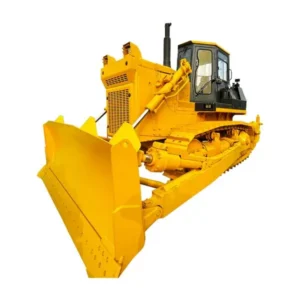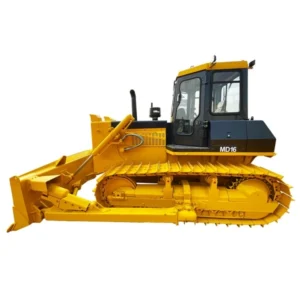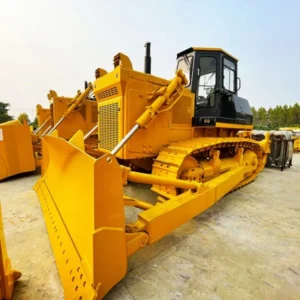مقدمة

Dozer machines, also known as bulldozers, are heavy-duty construction equipment designed to push large quantities of soil, sand, rubble, or other materials during construction or earthmoving projects. Their robust build and powerful engines make them indispensable in tackling challenging landscapes. In this blog post, we delve into the intricate workings of dozer machines and how they navigate through various terrains.
The Anatomy of a Dozer Machine
Dozer machines are characterized by their prominent blades mounted at the front, which are crucial for pushing and moving materials. These blades come in different shapes and sizes, including straight blades for simple pushing tasks and angled blades for more precise maneuvering. Additionally, modern dozer machines often feature advanced hydraulic systems that allow for precise control of the blade’s movement and angle, enhancing their efficiency and versatility on the job site.
انواع من Dozer Machines
There are several types of dozer machines tailored to specific tasks and terrains. These include:
- الجرافات الزاحفة: Crawler dozers, also known as track dozers, are characterized by their continuous tracks that distribute the weight of the machine over a larger surface area, providing exceptional traction and stability. This design makes crawler dozers well-suited for navigating challenging terrain, including muddy or uneven ground. Their ability to exert significant force while maintaining grip makes them indispensable in earthmoving and construction projects where precision and power are paramount. Additionally, crawler dozers often feature adjustable blade angles and advanced hydraulic systems, enhancing their versatility and efficiency on the job site.
- الجرافات ذات العجلات: Wheel dozers, as the name suggests, are equipped with wheels instead of tracks. This design offers advantages in terms of speed and mobility, making wheel dozers ideal for applications where rapid movement across large distances is required, such as in mining or quarry operations. The wheel configuration allows for faster travel speeds compared to crawler dozers, making them well-suited for large-scale earthmoving projects where efficiency and productivity are key. While wheel dozers may not provide the same level of traction as their crawler counterparts, they excel in tasks that demand agility and maneuverability.
- الجرافات الصغيرة: Mini dozers, also referred to as compact dozers or skid steer dozers, are smaller in size compared to traditional crawler or wheel dozers. Despite their compact footprint, mini dozers are equipped with powerful engines and robust hydraulic systems, allowing them to tackle light to medium-duty tasks with precision and efficiency. Their maneuverability and agility make them perfect for navigating tight spaces or operating in confined areas where larger machines may struggle to access. Mini dozers are commonly used in landscaping, residential construction, and utility maintenance projects, where versatility and compactness are essential.
Challenges Faced by Dozer Operators
Operating a dozer machine requires skill and experience, especially when confronted with challenging landscapes. Some common obstacles faced by dozer operators include:
- Steep Slopes: Operating a dozer on steep slopes presents numerous challenges for operators. Maneuvering a heavy machine on inclines requires a delicate balance of throttle control, steering, and blade manipulation to prevent accidents or loss of control. The risk of tipping or rolling over is heightened on steep slopes, necessitating caution and precision in every movement. Moreover, changes in terrain gradient can affect traction and stability, further complicating the task. Dozer operators must undergo specialized training to navigate steep slopes safely and effectively, including techniques for managing downhill descents and mitigating the risk of rollovers.
- Rocky Terrain: Rocky terrain poses a formidable challenge to dozer machines and operators alike. Rocks and boulders scattered across the ground can damage the blade, tracks, or undercarriage if not navigated carefully. Impacting large rocks can also jolt the operator and potentially cause equipment malfunctions. To overcome this challenge, operators must exercise keen observation skills and strategic planning to identify safe paths through rocky terrain. Additionally, some dozer machines are equipped with protective features such as reinforced blades or rock guards to minimize damage from impacts. Nevertheless, operating in rocky terrain remains a demanding task that requires skill, patience, and meticulous attention to detail.
- Soft Soil: Soft or marshy ground presents unique challenges for dozer operators, as the risk of getting stuck or causing excessive soil compaction is heightened. Operating heavy machinery on soft soil requires careful navigation to avoid sinking or creating deep ruts that can impede progress. Operators must constantly assess the ground conditions and adjust their approach accordingly, redistributing weight and adjusting blade angles to minimize soil disturbance. In some cases, specialized attachments such as swamp tracks or wide tracks may be employed to improve flotation and reduce ground pressure. Furthermore, environmental considerations must be taken into account to minimize the impact on delicate ecosystems when operating in marshy areas.
Comparison of Different Types of Dozer Machines

| Feature | Crawler Dozer | Wheel Dozer | Mini Dozer |
|---|---|---|---|
| Traction | Excellent | Moderate to Good | Good |
| Mobility | Moderate | Excellent | Excellent |
| Size | كبير | كبير | Compact |
| Terrain Versatility | Versatile | Limited | Limited |
خاتمة
Dozer machines play a crucial role in modern construction and earthmoving projects, offering unmatched power and versatility in tackling challenging landscapes. From crawler dozers conquering rugged terrain to mini dozers navigating tight spaces with ease, these robust machines continue to shape the world around us.
التعليمات
Q:What are the main components of a dozer machine?
A:The main components include the blade, tracks or wheels, engine, hydraulic system, and cab for the operator.
Q:How do dozer machines handle different types of terrain?
A:Dozer machines utilize their traction, power, and advanced hydraulic systems to navigate through various terrains, adapting their approach based on the specific challenges presented.
Q:What safety precautions should be taken when operating a dozer machine?
A:Operators should undergo proper training, wear appropriate safety gear, perform regular maintenance checks, and adhere to safety protocols to minimize the risk of accidents or injuries.
Q:Can dozer machines be used for tasks other than earthmoving?
A:Yes, dozer machines are versatile and can be equipped with various attachments such as rippers, winches, and blades, allowing them to perform tasks like land clearing, grading, and even snow removal.








-150x150.webp)
